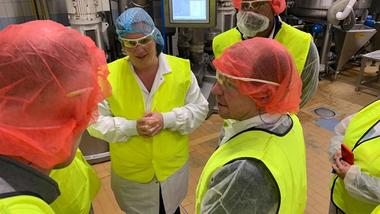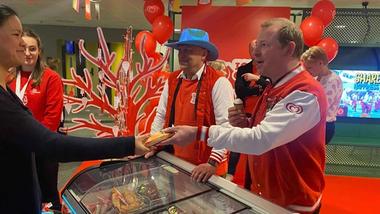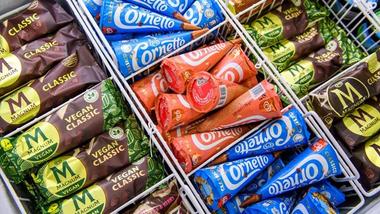Matt Close was appointed President of Unilever’s Ice Cream Business Group in April 2022. Before this he was EVP for Global Ice Cream for six years. He navigated ice cream through three tough Covid years by accelerating quick commerce, digitalising out-of-home as much as possible and stepping up premium innovation to bring joy to people’s homes, delivering smiles even when the world had to stay indoors.
Career and leadership
Matt, have you always worked in ice cream?
Mostly, yes. I joined Birds Eye Wall’s, Unilever’s frozen food and ice cream company, as part of Unilever’s Future Leaders Programme in 1992. I did various ice cream roles for the first 11 years. I then spent eight years leading Personal Care and Home Care in the UK & Ireland before coming back home to Ice Cream in 2011. I have 22 ice cream summers under my belt now and have led the business for the past seven.
What attracted you to working at Unilever?
It was and remains an unparalleled learning environment. I have always been attracted to our mission to prove that sustainable business can be a driver of competitive, consistently high performance. That’s certainly a factor and something I still hold dear.
What do you find most rewarding about your job?
My job is about delivering happiness. We talk about happy people for a happy planet, winning smiles. As the world’s largest ice cream company, we’ve spent the last 100 years bringing happiness through ice cream around the world. In 2022 we created 28 billion smiles with consumers, where they enjoyed an ice cream – that’s a whole lot of joy!
We believe in creating an unbroken chain of happiness across our value chain – making and selling ice cream in even more sustainable ways for a happy planet. That’s at the heart of how I lead and the difference I can make.
How would you describe your leadership style?
I’m a ‘people first’ leader. I truly believe that happier people deliver better performance and results.
I am very focused on having a clear strategy with real freedom in that strategic framework so we really liberate our talent to be engaged, fulfilled and able to thrive.
We have spent time codifying the culture we want in our ice cream business. It comes down to three pillars – caring for everyone, connecting people to people and making sure each team member feels truly valued.
In practice, that means a work environment where people want to work with and for each other, want to share stories of success but also failure, and where everyone feels safe to speak up about issues. I believe this enables us to make the business grow faster.
I’m also a marketer by training, so lavishing attention on making our brands distinctive and superior is at the heart of my leadership agenda. Building an unparalleled innovation machine is critical to winning in desire categories like ice cream.

Strategy, innovation and growth
What key differences has Unilever’s reorganisation delivered?
The big change for us is the ability to focus on the domain expertise needed in a frozen category, so we can get to market faster, make quicker decisions and take more experimental risks.
The ice cream business has some unique properties. We are a desire category. Nobody absolutely needs an ice cream (well ok, sometimes you do!), but lots of people want one. And that means making sure the brands work hard to be emotionally relevant and resonant.
Secondly, it doesn’t want to maintain its state. Ice cream wants to defrost. Having ice cream experts innovate at every step of the product lifecycle and take care of our products right through the cold chain allows us to deliver the best consumer experience.
Finally, it means we’re able to define our contribution to the company’s strategy as a singular ice cream business. How we get to net zero is very different from how other business groups will get there, and we’ve been able to call that out much more clearly.
What does it mean for decision-making and innovation?
We can focus on what makes the biggest difference to getting growth in ice cream.
One of our new business models is working to give digital tools to our customers to create better service for them. More than 2.5 million shopkeepers sell our ice cream. We are currently working to serve more than 1.4 million through digital tools, enabling them to order online and grow faster.
We have image capture technology inside nearly 50,000 ice cream cabinets right now. This uses AI to let shopkeepers know what to restock and submit orders in a frictionless way. It’s experimenting at scale to unlock growth the ice cream way.
In the past we might have struggled to get attention for our specific suite of tools, but not anymore, because they’re very, very important to ice cream people.
I see ideas that help us sell more ice cream moving much more quickly into markets, and our dedicated teams are much more engaged in evolving our business model to be future-fit than ever before.

How is this generating value and growth?
In 2022 ice cream grew 9%. In much of the world, ice cream is a very seasonal business, so maximising the return on our investment is better served as a dedicated business group.
Being separate also allows us to spend more time working on deseasonalising the turnover, especially through a dedicated approach to what we call ‘Ice Cream NOW’. This sees us working with digital players to get ice cream to anyone, anywhere and at any time.
We have also put the levers of growth and investment in the hands of our frontline teams. I’m much more confident that we can deliver our full potential as a business group by helping our people spend more time on what makes the biggest difference to the business and make the right trade-offs within ice cream to deliver overall value creation.
What does this mean for your markets?
In very simple terms, I approach the world through three clusters.
In the US, our big focus is on premiumisation and digital commerce, in a market that has the highest per capita consumption in the world. Focusing on Ben & Jerry’s, Talenti and Magnum is key while modernising our famous mainstream brands like Breyers, Klondike and Popsicle. Proven growth drivers are delivering distinctively superior experiences for the consumer and enabling them to order whenever they want.
In Europe, we have the same premiumisation focus with our true indulgence brands, Magnum and Ben & Jerry’s. We also want to be known for flawless execution of a brilliant out-of-home business to make sure we win those impulse moments.
In the emerging markets, we see it as our responsibility to develop the market by having a portfolio across the full price range, by being worth it and by being the best marketers.
It’s also about getting every freezer cabinet right. We call this the DAVE way, where the stock in every cabinet is: Desirable, Available, Visible and Executed brilliantly. We have great repeatable models from markets like Turkey, Mexico, China and Thailand that help us win everywhere.

What does it mean for the business’s progress to net zero?
Ice cream is around 12% of Unilever’s turnover and 20% of its greenhouse gas footprint.
We have a robust plan in place to reach net zero by 2039 by focusing on what I call our four Cs – cabinets, cows, cocoa and circularity.
The two most important ones from an emissions point of view are cows and cabinets.
Last year we started to work with 17 dairy cooperatives in the US and in the Netherlands to prove that we can reduce farm greenhouse gas emissions by 50% and we’ve started to see good initial results.
We also finished 2022 with our plant-based ice cream business representing 8% of ice cream’s turnover, so we’re making a big contribution to Unilever’s commitment to a €1.5 billion plant-based business by 2025.
Our goal for our fleet of ice cream freezer cabinets is to use green energy and less energy. In Germany, we have just completed a trial raising freezer temperatures from -18°C to -12°C, which could be a big contribution and required deep domain expertise to keep our product quality. Over the course of a three-month summer season, each of the cabinets used 25% less energy, which is a massive downscale on emissions.
With all of these initiatives, we always make sure we continue to deliver what the consumer expects, which is amazingly indulgent gorgeous products. There is no point in compromising the product experience for sustainability. This is our ‘and, and’ challenge.
Are there any brand examples that you would like to call on to illustrate that progress?
Ben & Jerry’s really typifies the sort of impact that we want to have.
It’s a brand that was born of dairy but is already a leader in the plant-based ice cream market in the US. And it’s achieved this while embarking on a radical programme dedicated to working with farmers to reduce the greenhouse gas emissions on their farms and for our products.

Trends and results
Are you pleased with Ice Cream’s results so far in 2023?
I’m pleased with the step-up in the quality of our execution.
I know that our grip in out-of-home is going up. I know our total distribution points for premium ice cream brands such as Magnum and Ben & Jerry’s are improving. I know our money is going behind fewer, more focused activities, because we’re measuring them.
I hate being the ice cream guy complaining about the weather but the start to the year has been colder and wetter than any we remember. It’s been decidedly unseasonal in many markets. The truth is a bit of good weather does help us. But ice cream people are optimistic, and the year is only getting going.
And as I’ve said, deseasonalising ice cream is a big part of our strategy. It’s always 20⁰C at home at 9pm on the sofa and our Ice Cream NOW programme, which looks to deliver ice cream to anyone, anytime and anywhere, has been phenomenally successful over the past four years, so we will continue to drive that.
Looking to the future
Are there any markets and channels that you are focusing on for growth?
Growth comes from really sharp execution of strategy by people who feel cared for and in turn care.
We expect our emerging markets to grow fastest as we drive market development, and we know that’s possible because we’ve been doing it for a long time.
Digital commerce will be critical. And we expect our out-of-home channel to be a big growth driver for ice cream, partly as we continue to recover from three horrible years of Covid, but also because we’re putting more focus on digitalising how shopkeepers manage their business.
The rest of Unilever has a bigger emerging markets footprint so while we will grow fast, I cannot overemphasise the role our very big markets play. It is critical for us to keep innovating and modernising in the US and Europe to achieve our vision.
Consumers want us to thrill and delight them and customers want us to prove we have category growth management in mind.
You have also stated your ambition for Cornetto to join Magnum and Ben & Jerry’s as a €1 billion brand. How bullish are you in terms of when that is going to happen?
With a good tailwind, it’s stretching but possible for Cornetto to get there this year. It’s game on for a big summer!
To make it happen we need everyone to keep a laser-sharp focus on the brand, starting with the amazing work our factories do to deliver outstanding quality in every cone.
We’ve given Cornetto more priority for the first time in seven years and have pivoted to bringing scale innovation to the brand right across the globe.
How will Ice Cream continue to grow sustainably?
Growing sustainably comes from a deep understanding of what consumers are looking for and meeting their needs better than our competitors.
To do that well, we need to leverage the global scale of brands like Magnum, Ben and Jerry’s and Cornetto, while making more of brands like Wall’s and Twister.
But sustainability obviously has a double meaning nowadays.
Consumers expect us to be moving away from plastic and recently we took our European ice cream tubs for Carte D’Or out of plastic and into recyclable paper.
They expect us to treat everyone in the supply chain fairly, and Magnum is working with cocoa and vanilla partners to make sure that there’s no deforestation or child labour in the system and that our farmers are able to achieve a living income.
It’s also about how we responsibly make our products. For all our ice creams, we’re committed to:
- 95% of packaged ice cream containing no more than 22g total sugar per serving by 2025
- 95% of packaged ice cream containing no more than 250 kcal per serving by 2025.
And we have even stricter criteria for our kids’ portfolio.
The challenge for our marketers is to tell all these stories in a way that makes our brands more appealing than competitive offerings. Our R&D folks have a big role to play too.

What do you think are the next big trends in ice cream? And what can we expect from Unilever in these spaces?
There are three. The first one is ever present and ever enduring – being unapologetically indulgent.
The second is around understanding the occasions where ice cream is most relevant so we can design new formats that really deliver against those occasions. We’ve seen stellar growth on all mini formats, especially Magnum Mini over the past eight years and minification will continue to be important.
The third is the ‘better for you’ space, be it plant-based, lower-sugar or diet-specific (but still great-tasting) ice creams. These are all areas that we’re actively innovating in and driving growth through right now.
And finally…
If you had the chance to ask a fellow business group leader a question, who would you ask and what would that question be?
I would ask my friend Richard Slater, our Chief R&D Officer, how we can make our packaging more circular.
